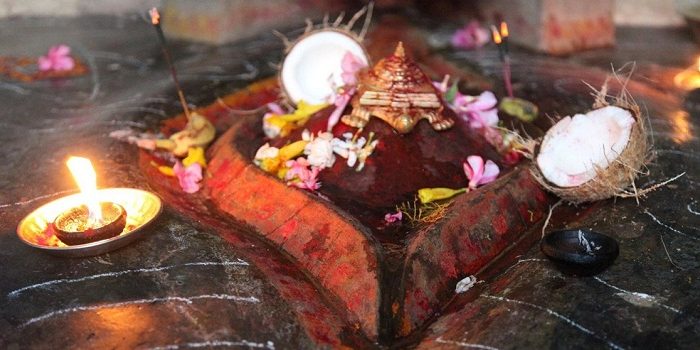In the previous two articles, an examination into the facet of Ashaucha and the facet of austerity and self-purification associated with Menstruation in the Hindu tradition was undertaken and it was shown how in spite of menstruating women entering a temporary period of Ashaucha (ritual impurity), the process itself is very beneficial and purificatory in nature.
We further saw how, Hindu scriptures implore women to consider menstruation as a period of austerity and take full benefit of the purification process, which is available exclusively to women.
In this article, let us take up another facet of the Hindu view of menstruation: a period of rest and sacred celebration.
Menstruation as a period of rest
Menstruation as a period of “rest” is another notion that is widely prevalent throughout India. Menstruating women often face discomfort, mood swings, and abdominal cramps. It is estimated that three out of four girls and women experience menstrual pain of varying intensity and one out of ten experiences such severe pain that they are unable to carry out their usual daily activities.
Though this is not an India-specific estimate, it does give a general idea regarding the prevalence of menstrual discomfort among girls and women irrespective of the geography.
This discomfort and pain make girls and women, across the world, prefer to take rest during menstruation and as a result, many have been found to take 1-2 days off from their schools and workplaces.
Therefore, the notion of rest is widely prevalent among modern urban women. But, what is interesting is the fact that this notion of rest is not only well recognized in the Hindu scriptures, it is also a dominant notion attached to traditional menstrual beliefs and practices among various communities.
Angirasa Smriti (Verse 37), for example, advises women to resume their household work only after their monthly periods stop. Similarly, Vashishta Dharmasutra (5.6) says that menstruating women should not indulge in physical exertion, be it household work, or activities like running.
During Ambubachi festival in Kamakhya temple in Assam, the temple is closed for three days to give rest to the Goddess, who is believed to be menstruating during that time. Similarly, during the Tulu festival called Keddasa in Karnataka, mother earth is believed to have begun her earthly menstrual cycle and is given a rest for three days.
This is also practiced during Raja Parva (menstruation festival) in Odisha, where farmers don’t plow the land and give rest to Goddess earth.
Frederique Apffel-Marglin, in her book ‘Rhythms of Life: Enacting the World with the Goddesses of Orissa,’ quotes a village woman from Odisha as saying thus:
“During the menses of the earth, women do no work; they play and sing with their friends. The sole reason is for them to rest, just like during their monthly periods, when they do not work and must not be disturbed, they should not be touched.”
Mitoo Das, in her paper ‘Menstruation as Pollution: Taboos in Simlitola, Assam,’ mentions that both the notions of menstruation as impurity and as a period of rest are prevalent among the people of Simlitola, Assam. She writes:
“The taboos prescribed are not only present because women are taken to be ‘pollutants’ or ‘impure’ during menstruation but also because women are considered to be physically weak during menses and thus the following of taboos, at least some of it, allow her ample ‘rest’. Thus Similitola society has a second way of explaining the need for the existence of such taboos, i.e. to make women rest.”
In modern times, Swami Chinmayananda has explained that menstruation restrictions were used as a means for providing rest to women, who otherwise indulged in physically demanding household tasks in the past, and who suffered from pain, stress, and discomfort during the menses.
Therefore, the notion of menstruation as a period of rest that the women need, owing to stress and physical discomfort, is clearly recognized by Hinduism, and some menstrual practices like preventing women from doing household work are aimed to serve that purpose.
Menstruation as a sacred celebration
The Hindu way of life perceives each element of an Individual’s life as sacred and worthy of worship and celebration. Thus, from the moment of birth, intake of first food, writing of first letters, till marriage, and death, every life event is associated with sacredness, worship, and celebration.
Even in death, wherein people always mourn, it is recognized that the journey of the Jivatma has not ended and the death rites aim to aid the Jivatma to regain new birth and continue its journey further. Thus, even Death rites are sacred and have the utmost importance in the Hindu scheme of things.
This attachment of sacredness-of a notion of worship and celebration- to various elements of life can be observed with respect to menstruation and menstruating women as well.
The best example that illustrates this is the celebration of ‘Ritu Kala Samskara’. Ritu Kala Samskara is the coming of age ceremony that celebrates the onset of menstruation among young girls. This is a highly localized ceremony that is celebrated across India based on local customs and traditions.
In Karnataka, the young girl, who has started menstruating, is dressed up and the Sumangali women (married women) from the neighborhood perform her Aarti (showing of the lamp, light from a wick as in Puja) and sing songs.
The girl is then given Chigali unde (a dish made of sesame seeds and jaggery that is believed to help in proper flow), Tambula (a combination of coconut, betel leaves, etc. offered to the deity in puja or given to guests) and gifts. A similar ceremony could be observed in Kerala and Andhra Pradesh as well.
On the other hand, the celebration is carried out in much fanfare for three full days in Tamil Nadu, where it is called as ‘Manjal Neerattu Vizha’ (turmeric bathing ceremony). The highlight of this festival is that the girl undergoes ritual seclusion, ritual bathing, and many other local customs, including turmeric bathing ceremony.
Friends and family are invited and the girl is gifted silk sarees and she wears a Saree (or a half-saree) for the first time. The entire ceremony happens with much elaboration and pomp, and in many ways, it resembles a mini-version of a marriage. (A detailed account of the event can be found here. A video here).
In North India, the celebration happens quietly and the young girls are taught about menstruation practices and are asked to maintain seclusion. In Assam, the celebration is called as ‘Xoru Biya’, which means ‘small marriage’. Thus, across India, one observes various localized customs and ceremonies that celebrate the onset of menstruation. What is common in all these ceremonies is the fact that the ceremonies are aimed at:
- Imparting a very positive notion about menstruation in the mind of the girl: The girl is treated as special and is given gifts. She is perceived as a manifestation of the Supreme Goddess and is worshipped with Aarti. The young girl is welcomed with open hands into womanhood and the ritual allows her to accept the changes that come along with puberty in a positive and welcoming spirit. She is made to feel confident and happy in her feminine identity.
- Imparting knowledge that equips the young girl well to adjust to her on-coming physical and emotional changes during puberty; imparting knowledge regarding various menstruation practices that the girl must follow and the reasons and benefits of those practices.
It is a different issue that on the ground, many of these practices have today picked up a highly negative connotation, largely due to the fact that they have been reduced to blind mechanical restrictions that ignorant and ill-informed parents are imparting to their young children by packaging them as ‘forbidden practices/superstitions’.
This may also be the result of “modernization” and “convent education” that takes on Christian ideas of taboo subjects and impurity.) But, if we were to consider the essence of the traditions and the knowledge preserved in them on their own standing, it will become clear that the Hindu ceremonies associated with the onset of menstruation perceive menstruation and menstruating women in a highly positive manner. It associates menstruation with womanhood and a woman’s ability to give birth to life.
And various menstruation practices, as we shall see later, are aimed at facilitating women to understand their own individuality better and help her lead a more fulfilling life. Thus, these ceremonies associated with the onset of menstruation forms an important Hindu practice that aims to impart the notion of menstruation as a sacred celebration.
This association of menstruation with sacredness is further reinforced in the Tantric practices like Yoni Puja (worship of the female Yoni), wherein ritual worship is carried out not only of a woman but also of her Yoni, which is perceived as a symbol for Cosmic Yoni from which the entire universe has emerged.
Menstrual blood is considered, pure and sacred, and plays a very important role in these rituals. The Yoni Tantra, in facts, says that the Yoni puja must be carried out only in the Yoni, which has started menstruating.
Similarly, the Bauls of Bengal- a syncretic group of mystic singers and dancers, whose religious beliefs are influenced by Vaishnava, Sakta, Tantric Buddhism, Samkhya, and Sufi belief systems- practice Deha Sadhana (spiritual practice using the body), a form of sexual yoga, wherein sexual energy is transformed into Prema (divine love) and Spiritual ecstasy.
The Bauls believe that men and women are abodes of two different aspects of the Divine. The women’s Nir i.e. sexual fluid (literally water) contains one aspect of the divine, which is believed to descend down in the form of a fish during the monthly periods.
Similarly, the men’s Kshir i.e. semen (literally milk) is said to contain the other aspect of the divine. The Bauls believe that through the ritual practice of sexual Yoga during menstruation, the ‘fish’ (the feminine aspect of the divine) that ‘swims’ in the menstrual fluid could be united with the Kshir and a state of Yogic bliss or Ananda can be attained.
In other words, the Bauls perform sexual intercourse during menstruation as a means for attaining divine bliss and spiritual emancipation. It is important to note that this sexual intercourse indulged as part of Deha Sadhana, is purely a devotional act and should not be confused with sexual intercourse indulged in for the sake of sensual pleasure or conception.
The importance of menstruation during the Deha Sadhana can also be understood by the fact that the time of monthly periods is called “Mahayoga” (Great Yoga), and the first and the third day of menstruation is designated as “Amavasya” (New Moon) and “Poornima” (Full Moon) respectively. [June McDaniel, The Embodiment of God among the Bāuls of Bengal, Journal of Feminist Studies in Religion, Vol. 8, No. 2 (Fall, 1992), pp. 27-39]
Devipuram is a temple in Andhra Pradesh, which is an important center of Devi worship in the Tantric tradition of Srividya. The temple itself has been built in the form of Sri Chakra- the abode of the Supreme Goddess Lalita Tripurasundari, and it contains a Kamakhya Peetham- a naturally formed Yoni.
Speaking to Sinu Joseph of ‘Mythri Speaks’, Sri Amritananda Natha Saraswati, the founder of Devipuram and a practitioner of Srividya, said that most of the priests in his temple were women and they were all free to stay at the temple during their monthly periods.
He further said: “What is pure, we don’t touch. And what we don’t touch, we call it a Taboo. She (a menstruating woman) was so pure, that she was worshipped as a Goddess. The reason for not having a woman go into a temple is precisely this. She is a living Goddess at that time. The energy of the God or Goddess which is there in the Murti will move over to her, and that (the Murti) becomes lifeless, while this (the menstruating woman) is life. So that’s why they were prevented from entering the temple.”
Thus, Guruji of Devipuram, clearly associated purity with menstruation and considered menstruating women as living Goddesses, while also highlighting the fact that the practice of menstruating women not being allowed into temples was rooted in the fact that there will be an imbalance in the energy of the temple.
It is to be noted that much of the Tantrika practices and the associated worldview, are highly tailor-made and their applicability is limited to a particular place, context, rituals, and to the competent practitioners of these rituals alone and not to the general society.
Yet, despite this limited application, what the texts like Yoni tantra, practices like Deha Sadhana of Bauls, or the views of Devipuram Guruji, establish is the fact that Hinduism does not put forward a blanket worldview on any issue.
Instead, Hindu tradition and practices are tailor-made based on different situations, goals, competencies, and needs of the people. As a result, menstruation, which is otherwise rightly associated with ritual Ashaucha and hence sexual intercourse and sacred activities like worship are restricted, becomes associated with ritual Shaucha and sexual intercourse in the case of Yoni puja and Deha Sadhana, respectively.
The role played by menstruation in various acts of spiritual and religious practice, clearly depict their association with worship and sacredness.
But, it is in the festivals associated with the menstruation of the Hindu Goddesses that one will witness the full splendor with which menstruation is celebrated.
It is only in these festivals that the full implication of the notion of menstruation as a sacred celebration will become evident. One such example is the celebration of the Ambubachi festival in Kamakhya, Assam.
As mentioned before, Goddess Kamakhya is believed to undergo a menstruation course for three days every year and the temple is closed for the period to give her rest. The festival is celebrated during the monsoon period, in the Assamese month of Ahaar, which falls in June.
For three days, the Goddess undergoes Ashaucha and takes rest. People in the region do not perform any farming activity to give the Mother, who is also the same as mother Earth, rest. Similarly, daily worship and religious performances are halted because of Ashaucha.
During the period, Goddess Kamakhya, who exists as naturally formed Yoni in the stone, is covered with a red cloth. On the fourth day, after the Yoni is bathed and ritually worshipped, the temple doors are opened and devotees are given special Prasada- a piece of the red cloth, which was used to cover Yoni and which has become moist due to Mother’s bleeding (in the form of natural springs).
The special Prasada is considered highly auspicious and purifying in nature and hence thousands of devotees from faraway places come every year to pray to the Mother and have her Special Prasada.
The four-day festival is accompanied by huge celebrations in the form of four-day Mela (fair) called Ameti, wherein Tantric Sadhus and Babas from across India visit and rural crafts are exhibited.
The Ambhubachi festival serves as a practical illustration of how Hinduism harmoniously integrates different nuances associated with various aspects of menstruation- Ashaucha, austerity, rest, and celebration- into one integral festival that is beneficial to everyone.
Another example that illustrates the notion of menstruation as a celebration, is the festival of Raja in Odisha. Just like Ambubachi festival, Raja festival is also celebrated during June and the Menstruating Goddess (Bhu-devi/Earth Goddess) who is worshipped here is variously known as Harchandi, Prithibt, Thakurant, Basudha, Draupadi.
The festival is celebrated by both men and women and women consider themselves as Amsha (parts) of the Goddess and the whole celebration happens around women.
Kartikeya C. Patel, in his paper- “Women, Earth, and the Goddess: A Shākta-Hindu Interpretation of Embodied Religion”, quotes an Odiya woman, who participated in the field study on menstruation festival in Odisha conducted by Frederique Apffel-Marglin and Purna Chandra Misra, as saying:
“Harchandi is at her menses; three days are gone and tomorrow is Thakurant Gadua. After taking bath as the girls will do, so also she will do. The red color will be thrown on her so it will appear as if she is bleeding. Pouring this red on her they will treat her as if she were menstruating … yes, that cloth on which the red is thrown will be put in a bucket of water so the water will be red. The priest will show it to the pilgrims and say ‘this is the blood of Thakurani.’ People out of joy and happiness will take that water.”
The women in Federique Apffel-Margin study strongly believed that ‘Stridharma’ of women and the Goddess must be respected and they should be allowed to rest during menstruation, so that the process of menstruation, which in women affects them at different levels of their being, and which in case of the Goddess, affects the cyclical continuity of life in nature and maintains balance, remains undisturbed and unaffected. Similarly, any disturbance to the menstruation will result in unpleasant effects.
Regarding how the festival of Raja connects Dharma, Happiness, and menstruation, Patel writes:
“Hence, religious (dharmic) happiness is directly linked to the happiness and worship of the feminine. Giving happiness to women, the earth, and the Goddess partly depends on not disturbing them during their menstruation. During the menstruation festival, the earth must not be dug or plowed and one must not walk on the earth barefoot as that would hurt or disturb her. In the same vein, women should be given rest during their menstruation and should not be disturbed…. But giving rest to mother earth or to women during the menstruation period is only one way to make them happy. Another way to make them happy, and thereby make religious (dharmic) life happy, consists in worshipping the female body with offerings. The men at Harchandi offer sacrificial animals to the Goddess to make her happy…. Similarly, women are kept happy by being given clothes, ornaments, and leisure time.”
Thus, the festival of Raja, beautifully weaves various elements of rest, merriment, worship, and celebration around Menstruation. The women are treated as a manifestation of the Goddess and menstruation is recognized as a positive “natural” process that is very vital for women as well as for nature.
The seclusion (away from men), resting, and other menstrual practices are recognized as facilitating women to take rest-so that the menstrual process happens without any disturbance, to play, and to make merriment.
And since, menstrual cycle as a whole is associated with fertility and bringing new life into this world, the whole activity is treated as a sacred celebration, and men are obliged to give happiness to the womenfolk.
Chengannur Mahadeva Kshetram in the southern state of Kerala is yet another place, where the Goddess menstruates and her menstruation is celebrated. Every few months, the Murti of Goddess Parvati (Bhagavati), which is present at the temple is believed to menstruate, and during that period, for three days, her Murti is shifted to a separate room and is given rest.
Whether the Goddess is menstruating or not is determined by the wife of the Supreme priest of Sabarimala, who regularly inspects the Udayada (the inner skirt) of the Goddess for any bloodstains. If any stains of menstrual blood are found, then the temple announces the celebration of the festival-‘Thriputharattu’.
For the first three days, the Murti of Goddess is secluded from the Murti of her husband Lord Shiva, and is allowed to rest. She undergoes all menstrual practices that women undergo and temple women sleep outside her room during the night to give company to the Goddess.
On the fourth day, the Goddess is taken on a female elephant to the Pamba River for a ritual bath. She is then dressed in grand clothes and jewelry and numerous ceremonies and elaborate rituals are performed. Thousands of people from across Kerala visit the temple to participate in this festival.
The Keddasa festival celebrated in the Dakshina Kannada district of Karnataka is another festival, which demonstrates the association of menstruation with notions of rest and sacred celebration.
The festival is celebrated for three days by the Tulu speaking population of the said district. The ancient festival is celebrated in honor of the annual initiation of the fertility season (agriculture) of the Mother Earth.
Tulu people believe that Mother Earth undergoes menstruation like women for three days and afterward, she becomes ready to give birth to crops and fruits. The festival is celebrated on the last three days of the Tulu month known as ‘Puyintel’, which roughly falls in January or February, each year.
The farmers give complete rest to mother earth on all three days and hence a number of activities like digging, trenching, cutting trees, etc. are stopped during the period. They worship the land and distribute Navadhanya (a mixture of nine grains) among kith and kin. On the fourth day, they begin sowing activities by first sprinkling turmeric and oil on the ground.
Though celebrations of menstruation festivals on a grand scale is limited to few pockets, the notion of menstruation as a celebration itself is widespread across India. Quoting the historian NN Bhattacharyya, Janet Chawla in her paper
“The Mythic Origins of the Menstrual Taboo in the Rig Veda” writes: “According to historian N.N.Bhattacharyya, different areas of India have had notions of the menstruating goddess. In Punjab, it was believed that Mother Earth (‘Dharti Ma’) ‘slept’ for a week each month. In some parts of the Deccan after the ‘navaratra’ goddess temples were closed from the tenth to the full moon day while she rests and refreshes herself. In the Malabar region, Mother Earth was believed to rest during the hot weather until she got the first shower of rain.” She further writes: “Bhattarcharyya notes that the auspiciousness of menstruation, representing potential fertility, is symbolized by blood or the color of blood and is regarded as sacred…..Deities and sacred objects are daubed with red coloring as a part of ritual worship. Within Indian culture, red signifies auspiciousness and potential growth – these ancient religious ideas and symbols are definitely linked to the blood of menstruation.”
Therefore, it is quite clear that the Hindu tradition recognizes menstruation as a sacred and a positive process, which must be respected, worshipped, and celebrated.
Though women become associated with temporary Ashaucha, this does not degrade them or make them inferior. Instead, the whole process is considered as highly sacred and purifying in nature, which sets women free from Karmic bondage.
Women are thus encouraged to perceive menstruation as a privilege available exclusively for them. They are advised to treat the monthly periods as a period of austerity, self-purification, rest, and relaxation.
More importantly, Hinduism promotes menstruation as a period of sacred celebration. Thus, Hinduism harmoniously integrates various elements of Ashaucha, austerity, purification, rest, sacredness, and celebration into menstruation process and practices, and facilitates women to attain overall well-being.
In the next part, we will look at Menstruation from a Yogic perspective.
Explore Hindu View of Menstruation Part I, II
The writer has published an exhaustive research book on the subject titled ‘Menstruation Across Cultures: A Historical Perspective’ and is available on Amazon
Disclaimer: The facts and opinions expressed in this article are the personal opinions of the author. Indic Today does not assume any responsibility or liability for the accuracy, completeness, suitability, or validity of any information in this article.
This Series was first published on India Facts.
Image credit: maakamakhya.org
Disclaimer: The opinions expressed in this article belong to the author. Indic Today is neither responsible nor liable for the accuracy, completeness, suitability, or validity of any information in the article.










